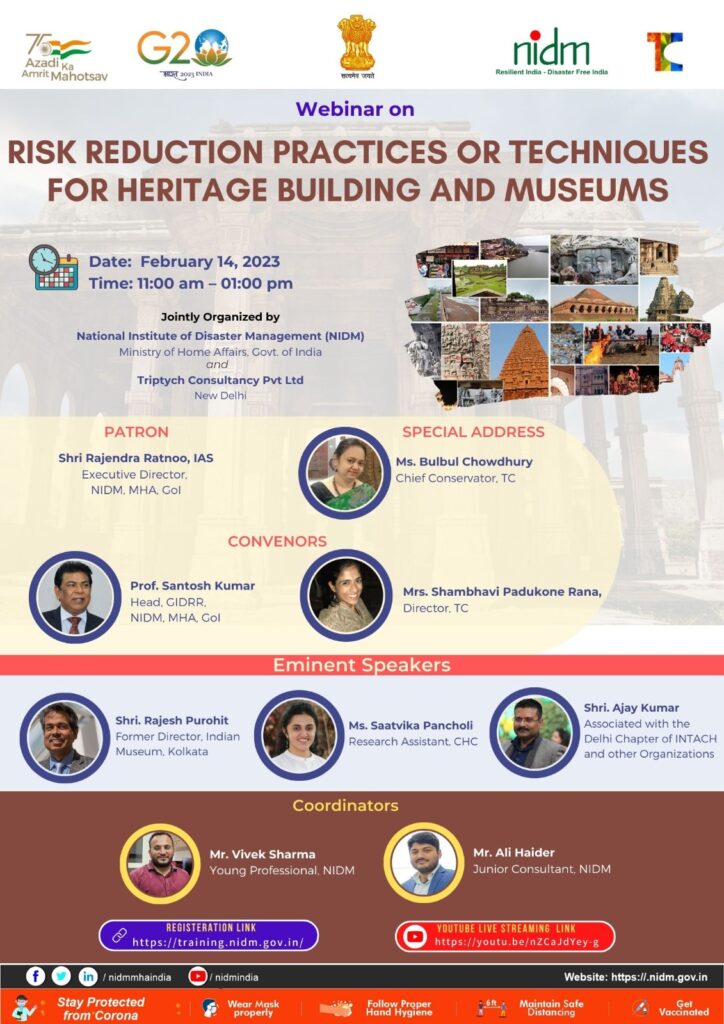Cultural Info.

Risk Reduction Practices or Techniques For Heritage Building and Museums
As the world has recently witnessed the tragic earthquake disaster which has occurred in Turkey and Syria our topic regarding risk reduction and mitigation of cultural heritage becomes more relevant with the present situation.
This has not the first incident which has happened in the world, one can find numerous incidents of such disaster across the world as you may remember in Khatmandu, Nepal, in the state of Uttarakhand, in the national capital New Delhi, Bhuj in Gujrat and the list goes on. In such circumstances, risk assessment becomes the key factor in reducing the damage towards the cultural heritage. Risk reduction in museums and of the museum collection becomes an important element in the disaster management programs in respect to cultural heritage as museums are not only the sanctuary of the material culture but at times are heritage structures themselves. Monuments and residence and other built structures with traditional architectural practices which have been a cultural symbol are largely affected by these natural and man-made calamities and are lost and forgotten. Today we have congregated to create a dialogue with few experts to bring forth their experiences in respect to the risk reduction and mitigation strategies that can beneficial for minimizing the affects of such calamities.
YouTube Link: https://www.youtube.com/watch?v=nZCaJdYey-g

7 Wonders of India : Exploration of Indian Art, Culture, Heritage, Yoga and Peace
As India powers through in the global scenario, be it trade & commerce, technology and development among many other sectors the legacy of our Indian heritage is what gives us our identity and defines our values. India is an ancient civilisation and As one of the richest nations in terms of cultural heritage. This richness is visible in both the tangible heritage, i.e. monuments and other physical manifestations and edifices, and the intangible heritage comprising language, music and dance, amongst many other practices and customs. By their very nature, these physical and intangible artifacts of heritage belong to every Indian and, by extension, to all of humanity.
The original concept or the list of the 7 wonders of the world came from Greece and pertains to the Mediterranean region. It is a list of remarkable constructions of classical antiquity given by various authors in guidebooks or poems popular among ancient Hellenic tourists.Through the years, the label of “seven wonders” has given rise to innumerable versions among international organizations, publications and individuals based on different themes as natural formations, ancient to modern structural masterpieces, living customs and practices, etc.
While in India, due to the sheer number of spectacular sites, it is near impossible to restrict ourselves to the number seven. The purpose of the seminar was to highlight the 7 wonders of India that reflects a universal achievement of humanity, a legacy of Indian Heritage to the entire world.

Atmabal - A Glimpse into the World of Museum
Museums world over, but now slowly in India, are more open to innovations. Disciplinary boundaries have become more porous, and museums are incorporating new media, new technologies and new strategies for interpretation.The museum experience has evolved dramtically, becoming interactive, paticipatory, and enaging in ways that would have been unimaginable twenty years ago.
As experiments and techniques mature, immersive storytelling has become the next frontier for museums. This is for two reasons. First, audience expectations has changed dramatically, especially in response to digital entertainment, video games, and the internet. People are no longer content to sit back passively. They want to feel part of the experience.Second, advance in technology- cheaper screens, greater image quality and increased computing power- have opened exciting possibilities for the storytellers, artists and designers and offer new ways to shape how people learn about art history.
Youtube Link: https://youtu.be/Y5j1nD9nKc8
